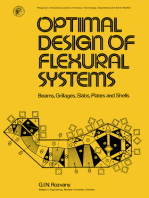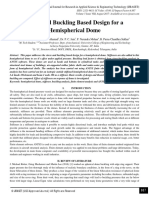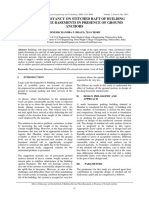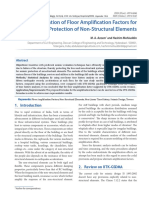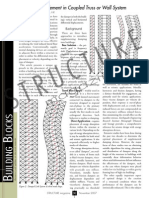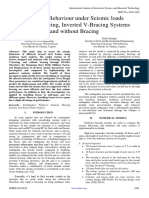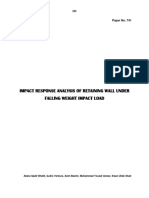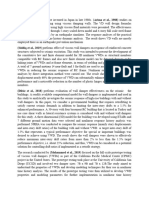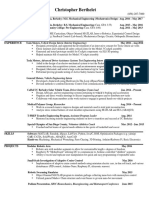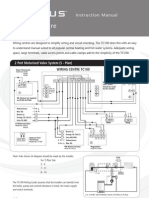Professional Documents
Culture Documents
Factors Influencing The Optimal Location and Orientation of Dampers in An R.C.C. Building
Original Title
Copyright
Available Formats
Share this document
Did you find this document useful?
Is this content inappropriate?
Report this DocumentCopyright:
Available Formats
Factors Influencing The Optimal Location and Orientation of Dampers in An R.C.C. Building
Copyright:
Available Formats
Volume 6, Issue 7, July – 2021 International Journal of Innovative Science and Research Technology
ISSN No:-2456-2165
Factors Influencing the Optimal Location and
Orientation of Dampers in an R.C.C. Building
Ashish Kumar Raunak Joshi
Dept. Of Civil Engineering, Dept. Of Civil Engineering,
MIT School of Engineering, MIT School of Engineering,
MIT ADT University, Pune, Maharashtra, India MIT ADT University, Pune, Maharashtra, India
Abhishek Arge Prof. Aniket D.Patil
Dept. Of Civil Engineering, Dept. Of Civil Engineering,
MIT School of Engineering, MIT School of Engineering,
MIT ADT University, Pune, Maharashtra, India MIT ADT University, Pune, Maharashtra, India
Abstract:- Seismic Dampers have been used for years as viscous dampers were used for energy dissipation in the
means to protect structures from adverse effects of simulations run as a part of experimentation for this paper.
earthquakes. However, dampers cannot be placed in FVDs or Fluid Viscous Dampers were chosen in particular
buildings in a random fashion. The efficacy of dampers because of their easy availability in the market. According
depends on their location and orientation. The objective of to Adithya G. S & H. Narendra, the introduction of
this experiment is to determine how any alteration in the dampers in a RC structure considerably reduces
aforementioned factors affects the efficacy of these dampers. displacements and forces on each storey. The
In this project, 2D models were formulated and simulations experimentation conducted by Prakriti Chandrakar and Dr.
were run to determine the factors affecting the optimal P. S. Bokare suggests that Response Spectrum analysis and
location and position of dampers. The simulations were run Time History method can be used to determine the effect of
on the ETABS software. The Response Spectrum Analysis dampers on response of a structure. It also suggests that
method was incorporated using the IS 1893-2016. The Response Spectrum analysis yields a greater value of storey
results of this experimentation will help placing the dampers displacement than Time History method on any given
in a building in an economic way. Dampers were found to be storey. Thus, Response Spectrum Analysis was used in this
most effective when placed in the lower storeys of a building. experimentation. This helps to determine the peak values of
Also, placing dampers closer to the centroidal axis increases responses in any given condition. In the paper presented by
their efficacy. When placing dampers side to side, it is SS Sanghai and PY Pawade, it can be inferred that when
recommended to place them in opposite orientations. the number of dampers placed in a structure is increased,
Orientation inversion is also recommended in consecutive the response of the structure considerably reduces. Also,
storeys. However, when it comes to giving priority to lower when a given number of dampers are placed at various
storey or closeness to centroidal axis, the latter was found to locations in a structure, the response of the building
be the governing factor. Above results will help placing changes. So, the scope of this paper is to determine how
dampers in the most efficient way, when the number of and where the dampers need to be placed in order to
dampers isrestricted. optimize the damping effect. The results of this
experimentation will help in determining the most
Keywords:- Dampers, Location, Orientation, ETABS, Response economic arrangement of dampers in a structure when the
Spectrum. number of dampers arefixed.
I. INTRODUCTION II. METHODOLOGY
The use of various energy absorption devices such as friction The objective of this paper is to optimize the location
dampers, viscoelastic dampers, viscous fluid dampers, and and orientation of dampers. In order to achieve the
metallic dampers in earthquake-resistant design and retrofitting objectives, following questions must be answered-
of structures has garnered a lot of attention in recent years. The ● What is the most suitable vertical position for adamper?
usage of these devices is recommended as they boost a ● What is the most suitable horizontal position for a
structure's energy dissipation capacity against moderate and damper?
intense earthquakes. This method offers an alternative to ● What is the most suitable orientation for dampers used in
traditional earthquake-resistant construction, with the potential pairs?
to considerably reduce seismic risk without jeopardizing the ● What is the governing factor when it comes to deciding
safety, reliability, or economic viability of the structures. Fluid the damper position – storey level or distance from the
IJISRT21JUL897 www.ijisrt.com 1202
Volume 6, Issue 7, July – 2021 International Journal of Innovative Science and Research Technology
ISSN No:-2456-2165
centroidal axis?
● Does inversion of direction of damper sets on consecutive
stories have any effect on thedamping?
● What sort of distribution of dampers is the most efficient way
to damp astructure?
For curating the answers to above questions, simulations
for various cases were run. The cases are described in the
upcoming sections.
III. TEST FRAMEDESCRIPTION
The simulations were carried out on a 4 bay, 10 storey
frame with storey height of 3m for each storey and a bay width
of 3m for each bay. The dampers used in the simulation had the
following properties, as listed in Table 1. The seismic data for
the simulation is listed in Table 2. The response spectrum was in
accordance with IS 1893:2016.
Table 1: Damper Properties Figure 1: Case Study 1 Model
Property of Damper Value
Link Type Damper - Exponential Case Study 2: Determining the optimal distance of damper
Weight 500 KN from the centroidal axis. (Horizontal Location)
Mass 98 kg In this case, a 4 bay 10 storey frame was used to
Directional Properties Fixed in U1 direction determine the effect of variation in damper position in
terms of distance from the centroidal axis, on the frame
Table 2: Seismic Data response. In the first simulation, two dampers were placed
Seismic Property Value on extreme ends of the base. In the second simulation, two
Zone V dampers were placed closer to the centroidal axis on the
Zone Factor (Z) 0.36 base as shown in figure 2 and3.
Importance Factor (I) 1
Soil Type II (Medium)
Response Reduction Factor (R) 5
Constant Damping Ratio 0.05
Scale Factor 0.98
The section properties of the R.C.C. elements are given in
Table 3.
Table 3: Section Properties
Section Properties Value
Beam Dimensions 230mm X 230mm
Column Dimensions 230mm X 230mm
Concrete Grade M30
Steel Grade Fe250
IV. TESTCASES
Case Study 1: Determining the optimal storey to place a damper.
(Vertical Position)
In this study, a 1 bay 10 storey frame, as shown in figure 1,
was used to observe the maximum displacement in each storey.
Figure 2: Case Study 2 - Model A
Multiple simulations were run by placing the damper at each
storey one at a time. The results were checked for the damper
location which yielded the least maximum displacement as
compared to all otherstoreys.
IJISRT21JUL897 www.ijisrt.com 1203
Volume 6, Issue 7, July – 2021 International Journal of Innovative Science and Research Technology
ISSN No:-2456-2165
Figure 3: Case Study 2 - Model B Figure 5: Case Study 3 - Model B
Case study 3: Orientation inversion when dampers are placed Case study 4: Governing factor in the selection of damper
side to side. location - vertical location or horizontal location.
In this case a 4 bay 10 storey frame was used to In this case a 4 bay 10 storey frame was used. This
determine the optimal orientation of dampers when placed side case was used to study the combined effect of 4 dampers
to side on the same storey. In both the simulations the dampers when vertical location is considered the governing factor and
were placed on the base storey in the second and third bay. In when horizontal location is considered the governing factor.
the first simulation, both the dampers were placed in a similar In the first simulation, all the four dampers are placed on the
orientation, i.e. facing the same direction; whereas in the base storey, making vertical location the governing factor. In
second simulation, both the dampers were placed in an the second simulation, two dampers were placed on the base
opposite orientation with respect to each other, i.e. in opposite story on bay 2 and 3, and the other two dampers were placed
directions as shown in figure 4 and 5. in a similar fashion on storey number 1, making horizontal
location, i.e. distance from the centroidal axis the governing
factor as shown in figure 6 and 7.
Figure 6: Case Study 4 - Model A
Figure 4: Case Study 3 - Model A
IJISRT21JUL897 www.ijisrt.com 1204
Volume 6, Issue 7, July – 2021 International Journal of Innovative Science and Research Technology
ISSN No:-2456-2165
Figure 7: Case Study 4 - Model B Figure 9: Case Study 5 - Model B
Case study 5: Orientation inversion when dampers are placed Case study 6: Distribution of Dampers
in the same bay on adjacentstoreys. In this case, multiple combinations of dampers were
In this case a 4 bay 10 storey frame was used to tested. 4 dampers were tested together in each simulation. In
determine the effect of change in orientation of dampers. 4 the first combination (the 3+1 system), two simulations were
dampers were used in pairs for each simulation. In the first run. In the first simulation, one damper was placed in the
simulation, both pairs of dampers were placed in different bottom storey whereas three dampers were placed at the
orientation on adjacent storeys. In the second simulation, both second and third storeys as shown in figure 10 (model 6A).
pairs of dampers were placed in the same orientation at In the second simulation, one damper was placed at the third
adjacent storeys, as shown in figures 8 and9. storey and the other three dampers were placed at the bottom
and first storeys as shown in figure 11 (model 6B).
In the second combination (the 2020 system), two
simulations were run. In the first simulation, a pair of
dampers was placed at the bottom storey and the other pair
was placed at the second storey (model 6C) as shown in
figure 12. In the second simulation, a pair of dampers was
placed at the first storey and the other was placed at the third
storey (model 6D) as shown in figure 13.
In the third combination (the even distribution system),
one damper was placed at every storey for all the three
simulations as shown in figures 14, 15 and 16. Model 6E, 6F
and 6G demonstrate the different arrangements of dampers
used in the three different simulations.
Figure 8: Case Study 5 - Model A
Figure 10: Case Study 6 - Model A
IJISRT21JUL897 www.ijisrt.com 1205
Volume 6, Issue 7, July – 2021 International Journal of Innovative Science and Research Technology
ISSN No:-2456-2165
Figure 11: Case Study 6 - ModelB Figure 14: Case Study 6 - ModelE
Figure 12: Case Study 6 - ModelC Figure 15: Case Study 6 - ModelF
Figure 16: Case Study 6 - ModelG
Figure 13: Case Study 6 - ModelD
IJISRT21JUL897 www.ijisrt.com 1206
Volume 6, Issue 7, July – 2021 International Journal of Innovative Science and Research Technology
ISSN No:-2456-2165
V. RESULTS
The results in the form of storey displacements for each
case study were recorded. The results are as follows –
Results from Case Study 1 –
Table 4: Maximum Storey Displacement readings from
simulations performed in Case Study 1.
Figure 18: Graph of Maximum Storey Displacement in
Case Study 2
Results from Case Study 3 –
Table 6: Graph of Maximum Storey Displacement in Case
Study 3
CASE 3
Storey Model A Model B
Storey 10 255.657 255.358
Storey 9 247.936 247.641
Storey 8 233.587 233.298
Storey 7 212.599 212.317
Storey 6 185.609 185.333
Storey 5 153.393 153.125
Storey 4 116.843 116.584
Storey 3 77.03 76.783
Storey 2 35.687 35.457
Storey 1 0.639 0.336
Base 0 0
Figure 17: Graph of Maximum Storey Displacement in Case
Study 1
Results from Case Study 2 –
Table 5: Maximum Storey Displacement readings from
simulations performed in Case Study 2.
CASE 2
Storey Model A Model B
Storey 10 256.404 255.657
Storey 9 248.66 247.936
Storey 8 234.291 233.587
Storey 7 213.279 212.599
Storey 6 186.257 185.609 Figure 19: Graph of Maximum Storey Displacement in
Storey 5 154.002 153.393 Case study 3
Storey 4 117.401 116.843
Storey 3 77.527 77.03
Storey 2 36.104 35.687
Storey 1 0.881 0.639
Base 0 0
IJISRT21JUL897 www.ijisrt.com 1207
Volume 6, Issue 7, July – 2021 International Journal of Innovative Science and Research Technology
ISSN No:-2456-2165
Results from Case Study 4 –
Table 7: Graph of Maximum Storey Displacement in Case
Study 4
CASE 4
Storey Model A Model B
Storey 10 255.232 202.465
Storey 9 247.517 194.994
Storey 8 233.177 180.963
Storey 7 212.199 160.399
Storey 6 185.219 134.048
Storey 5 153.014 102.906
Storey 4 116.476 68.204
Storey 3 76.679 31.762 Figure 21: Graph of Maximum Storey Displacement in Case
Storey 2 35.357 0.823 Study 5
Storey 1 0.228 0.24
Base 0 0 Results from Case Study 6 – Results of the 3+1 arrangement:
Table 9: Graph of Maximum Storey Displacement in Case
Study 6
CASE 6
Storey Model A Model B
Storey 10 155.455 153.36
Storey 9 148.002 145.99
Storey 8 133.772 131.924
Storey 7 113.078 111.4
Storey 6 87.043 85.475
Storey 5 57.461 55.901
Storey 4 31.124 29.584
Storey 3 29.665 25.674
Figure 20: Graph of Maximum Storey Displacement in Case Storey 2 28.307 2.284
Study 4 Storey 1 0.671 0.043
Base 0 0
Results from Case Study 5 –
Table 8: Graph of Maximum Storey Displacement in Case
Study 5
CASE 5
Storey Model A Model B
Storey 10 202.182 202.465
Storey 9 194.712 194.994
Storey 8 180.68 180.963
Storey 7 160.12 160.399
Storey 6 133.779 134.048
Storey 5 102.653 102.906
Storey 4 67.976 68.204
Storey 3 31.564 31.762
Storey 2 0.587 0.823
Storey 1 0.07 0.24
Figure 22: Graph of Maximum Storey Displacement in
Base 0 0
Case Study 6
IJISRT21JUL897 www.ijisrt.com 1208
Volume 6, Issue 7, July – 2021 International Journal of Innovative Science and Research Technology
ISSN No:-2456-2165
Results of the 2020 arrangement:
Table 10: Graph of Maximum Storey Displacement in Case
Study 6 - 2020 arrangement
CASE 6
Storey Model C Model D
Storey 10 190.696 261.514
Storey 9 183.197 255.278
Storey 8 169.009 243.361
Storey 7 148.221 225.67
Storey 6 121.65 202.672
Storey 5 90.435 175.439
Storey 4 56.379 150.553
Figure 24: Graph of Maximum Storey Displacement in Case
Storey 3 27.097 148.927
Study 6
Storey 2 26.141 121.728
Storey 1 0.326 120.383 Results comparing best cases from all three arrangements:
Base 0 0
Table 12: Graph of Maximum Storey Displacement in Case
Study 6 - Comparing best cases from all three arrangements
CASE6
Storey Model B Model E Model G
Storey 10 153.36 120.157 120.97
Storey 9 145.99 113.12 113.923
Storey 8 131.924 99.631 100.422
Storey 7 111.4 80.08 80.846
Storey 6 85.475 55.705 56.424
Storey 5 55.901 28.408 29.047
Storey 4 29.584 4.414 4.695
Storey 3 25.674 2.365 2.498
Storey 2 2.284 1.279 1.709
Figure 23: Graph of Maximum Storey Displacement in Case
Storey 1 0.043 0.089 0.393
Study 6
Base 0 0 0
Results of the even distribution arrangement:
Table 11: Graph of Maximum Storey Displacement in Case
Study 6 - Even Distribution arrangement
CASE6
Storey Model E Model F Model G
Storey 10 120.157 134.568 120.97
Storey 9 113.12 127.335 113.923
Storey 8 99.631 113.488 100.422
Storey 7 80.08 93.354 80.846
Storey 6 55.705 68.092 56.424
Storey 5 28.408 39.512 29.047
Storey 4 4.414 13.627 4.695
Storey 3 2.365 8.562 2.498
Storey 2 1.279 4.42 1.709 Figure 25: Graph of Maximum Storey Displacement in Case
Storey 1 0.089 1.324 0.393 Study 6
Base 0 0 0
IJISRT21JUL897 www.ijisrt.com 1209
Volume 6, Issue 7, July – 2021 International Journal of Innovative Science and Research Technology
ISSN No:-2456-2165
VI. DISCUSSIONS In the second combination (the 2020 system), we observe
that when a pair of dampers is placed at the bottom storey and
Case Study 1: Determining the optimal storey to place a the other pair at the second storey (model 6C, Figure 12), the
damper. (Vertical Position) efficiency of the frame increases as shown in Table 10 and
From this case, we can infer that, as the number of Figure 23.
storeys increases, the maximum displacement at each
floor increases as shown in Table 4 and Figure 17. Thus, In the third combination (the even distribution system),
we can conclude that when the damper is placed near to we can note that model 6F as shown in Figure 15 has high
the base, the damping efficiency of the frame increases. values of maximum displacement, followed by model 6G
(Figure 16), followed by model 6E (Figure 14) as shown in
Case Study 2: Determining the optimal distance of Table 11 and Figure 24. Thus, we can conclude that, when two
damper from the centroidal axis. (Horizontal Location). dampers behave as a single unit (model 6E), the resistance of
In this case, the values of maximum displacement the frame against seismic loads is the greatest among all other
as shown in Table 5 and Figure 18 suggest that when the miscellaneous cases adopted.
dampers are placed closer to the centroidal axis, the
efficiency of the frame increases as compared to the Furthermore, upon comparison of best arrangements of
dampers placed away from the centroidal axis. Thus, we all three types, it was found that an even distribution yields
can conclude that dampers are to be placed closer to the better results as shown in Table 12 and Figure25.
centroidal axis.
VII. CONCLUSIONS
Case study 3: Orientation inversion when dampers are
placed side to side. ● Dampers prove to be more efficient when placed on lower
In this case, the values of maximum displacement stories.
were higher when the dampers were placed in the same ● Dampers placed closer to the centroidal axis prove to be
direction as compared to the dampers which were placed moreeffective.
in opposite directions as shown in Table 6 and Figure 19. ● Dampers placed in opposite directions to each other prove
Thus we can conclude that, when dampers are placed to be moreefficient.
consecutively on the same storey, they are to be placed in ● The governing factor in deciding the position of a damper is
opposite directions so as to form a triangular shape. its closeness to the centroidalaxis.
● It’s found that inverting the direction of dampers on
Case study 4: Governing factor in the selection of alternate stories yields betterresults.
damper location - vertical location or horizontal location. ● An even distribution of dampers isrecommended.
This case was carried out to study whether dampers
perform more efficiently when the dampers are arranged ACKNOWLEDGMENT
on multiple storeys (closer to the centroidal axis) or when
all the dampers are placed at the base. The test results I am grateful to my respondents; whose cooperation
suggest that when the dampers are arranged on multiple played a major role in making this research possible. Not to
storeys (closer to the centroidal axis), the maximum forget, I am also thankful to my colleagues and every other
displacement on each storey is lesser as compared to person who has directly or indirectly helped me during the
when all the dampers are placed at the base as shown in preparation of my report. I am extremely thankful to all the
Table 7 and Figure 20. Thus we can conclude that the authors whose papers have helped me gain knowledge and
governing factor for damper arrangement is closeness to trigger ideas about the subject matter.
the centroidal axis.
REFERENCES
Case study 5: Orientation inversion when dampers are
placed in the same bay on adjacent storeys. [1]. Adithya, G. and H. Narendra. “PERFORMANCE
In this case, it is observed that when two pairs of EVALUATION OF FRICTION DAMPERS UNDER
dampers that face in the opposite direction, the value of SEISMIC LOADS.” International Journal of Research in
maximum displacement is lesser as compared to the two Engineering and Technology 05 (2016):10-15.
pairs of dampers which face in the same direction as [2]. Prakriti Chandrakar, Dr. P. S. Bokare, "Earthquake
shown in Table 8 and Figure 21. Thus, we can conclude Analysis of G+10 Building using Response Spectrum
that when two pairs of dampers are placed consecutively Method and Time
on floors, they should face the opposite direction [3]. History Method - A Comparison", International Journal
(inverted formation). of Science and Research (IJSR), Volume 6 Issue 8,
August 2017, 2124 – 2126
Case study 6: Distribution of Dampers [4]. Sanghai, Sanket&Pawade, Prashant. (2014). Effect of
In the first combination (the 3+1 system), it is Position and Number of Friction Dampers on Seismic
observed that when three dampers are placed at the Response of Frame. International Journal of earthsciences
bottom storeys and one at the mid-storey (model 6B, & engineering. 07.1854-1859.
Figure 11), the frame is more efficient against seismic
loads as shown in Table 9 and Figure 22
IJISRT21JUL897 www.ijisrt.com 1210
You might also like
- Optimal Design of Flexural Systems: Beams, Grillages, Slabs, Plates and ShellsFrom EverandOptimal Design of Flexural Systems: Beams, Grillages, Slabs, Plates and ShellsNo ratings yet
- Performance of R.C. Frames Coupled With Exponential Dampers Under Seismically Triggered ConditionDocument11 pagesPerformance of R.C. Frames Coupled With Exponential Dampers Under Seismically Triggered ConditionChethan GowdaNo ratings yet
- Numerical Analysis and Validation of Irregularity in Moment Frame Structure Due To Varying Location of Tuned Mass DamperDocument9 pagesNumerical Analysis and Validation of Irregularity in Moment Frame Structure Due To Varying Location of Tuned Mass DamperIJRASETPublicationsNo ratings yet
- Study and Analysis of Different Types of Dampers in Reducing The Vibration of StructureDocument9 pagesStudy and Analysis of Different Types of Dampers in Reducing The Vibration of StructureDivya MahalsekarNo ratings yet
- Forced Vibration Analysis of Inverted Umbrella Roof Shell Using AnsysDocument3 pagesForced Vibration Analysis of Inverted Umbrella Roof Shell Using AnsysWilson Andres Echeverri GutierrrezNo ratings yet
- Stress and Buckling Based Design For A Hemispherical DomeDocument9 pagesStress and Buckling Based Design For A Hemispherical DomeIJRASETPublicationsNo ratings yet
- Laxmi Helen MalathiDocument13 pagesLaxmi Helen MalathiMoha BishaarNo ratings yet
- (2002) Optimal Placement of Dampers For Passive Response ControlDocument22 pages(2002) Optimal Placement of Dampers For Passive Response ControlMohammad AshrafyNo ratings yet
- Comparative Study of Seismic Analysis of Dampers in Asymmetrical R.C. Frame BuildingDocument9 pagesComparative Study of Seismic Analysis of Dampers in Asymmetrical R.C. Frame BuildingIJRASETPublicationsNo ratings yet
- Application of Bousinesq's and Westergaard's Formulae in Analysing Foundation Stress Distribution For A Failed Telecommunication MastDocument7 pagesApplication of Bousinesq's and Westergaard's Formulae in Analysing Foundation Stress Distribution For A Failed Telecommunication MastJoshua Ian Gallardo AbanNo ratings yet
- Accidental Design Eccentricity Is It Important For The Inelastic Response of Buildings To Strong EarthquakesDocument16 pagesAccidental Design Eccentricity Is It Important For The Inelastic Response of Buildings To Strong EarthquakesmohamedNo ratings yet
- Seismic Dampers and The Factors Affecting Its Efficacy A Review PaperDocument5 pagesSeismic Dampers and The Factors Affecting Its Efficacy A Review PaperInternational Journal of Innovative Science and Research TechnologyNo ratings yet
- Comparative Study of Seismic Analysis of Bridge Substructure in Different Seismic Zones As Per IRC GuidelinesDocument9 pagesComparative Study of Seismic Analysis of Bridge Substructure in Different Seismic Zones As Per IRC GuidelinesIJRASETPublicationsNo ratings yet
- Inter Achieve 2004 Jinkoo (EESD)Document20 pagesInter Achieve 2004 Jinkoo (EESD)bristiNo ratings yet
- Lopez, D. (2002) - Efficiency of A Simple Approach To Damper Allocation in MDOF StructuresDocument12 pagesLopez, D. (2002) - Efficiency of A Simple Approach To Damper Allocation in MDOF StructuresEstructural TetzcocoNo ratings yet
- Arshiya Firdose 2022 IOP Conf. Ser. Earth Environ. Sci. 982 012076Document13 pagesArshiya Firdose 2022 IOP Conf. Ser. Earth Environ. Sci. 982 012076Mahade Hasan SinhaNo ratings yet
- Forced Vibration AnalysisDocument3 pagesForced Vibration AnalysisJournalNX - a Multidisciplinary Peer Reviewed JournalNo ratings yet
- Engineering Structures: SciencedirectDocument9 pagesEngineering Structures: Sciencedirectyasemin bürüngüzNo ratings yet
- Uplift Rock AnchorsDocument7 pagesUplift Rock AnchorsSantoshNo ratings yet
- 9 X October 2021Document9 pages9 X October 2021yashodharNo ratings yet
- Effect of Soil Structure Interaction On The DynamiDocument9 pagesEffect of Soil Structure Interaction On The DynamiUmair RazaNo ratings yet
- Experimental Study On Overall Flexural Deformation Response Control For Smart High-Rise StructuresDocument12 pagesExperimental Study On Overall Flexural Deformation Response Control For Smart High-Rise StructuresRenzo Vidalon NoriegasNo ratings yet
- Wind Load Analysis On Different Configuration On Stadium Light PoleDocument15 pagesWind Load Analysis On Different Configuration On Stadium Light PoleIJRASETPublicationsNo ratings yet
- Seismic Fragility Assessment of A Super Tall Building With Hybrid Control Strategy Using IDA MethodDocument14 pagesSeismic Fragility Assessment of A Super Tall Building With Hybrid Control Strategy Using IDA Methodsahand khalafiNo ratings yet
- V4i5 Ijertv4is051043Document9 pagesV4i5 Ijertv4is051043Joaquim Minusse TchamoNo ratings yet
- WCA ConacytCIDESI2022Document11 pagesWCA ConacytCIDESI2022WILFRIDO CALLEJA-ARRIAGANo ratings yet
- Study On The Effect of Viscous Dampers For RCC Frame StructureDocument40 pagesStudy On The Effect of Viscous Dampers For RCC Frame StructureNehal Pundalik RevankarNo ratings yet
- Bharathi Priya, CDocument9 pagesBharathi Priya, Cmbbb2No ratings yet
- Multi Storied BuildingDocument8 pagesMulti Storied BuildingJournalNX - a Multidisciplinary Peer Reviewed JournalNo ratings yet
- 10 EffectDocument9 pages10 EffectPandal RajNo ratings yet
- ZF 0712251258Document8 pagesZF 0712251258Md. Mizanur RahamanNo ratings yet
- P1 PDFDocument5 pagesP1 PDFAbdul AzeemNo ratings yet
- Research Paper For Dissertation 06-09-2023Document15 pagesResearch Paper For Dissertation 06-09-2023Shaikh ShujatNo ratings yet
- Effect of Variation in Geometrical Parameters On The Roof TrussesDocument5 pagesEffect of Variation in Geometrical Parameters On The Roof TrussesEditor IJRITCCNo ratings yet
- Analysis of Steel Plate Shear Wall System Using Finite Element AnalysisDocument8 pagesAnalysis of Steel Plate Shear Wall System Using Finite Element AnalysisIJRASETPublicationsNo ratings yet
- Vol IV Issue III Article 16 PDFDocument3 pagesVol IV Issue III Article 16 PDFpdhurveyNo ratings yet
- C BuildingBlocks Rahimian Nov071Document5 pagesC BuildingBlocks Rahimian Nov071Michael DixonNo ratings yet
- Ijresm V2 I8 86Document5 pagesIjresm V2 I8 86girumNo ratings yet
- 247 64 IJIRSET Paper TemplateDocument8 pages247 64 IJIRSET Paper TemplateshinthantNo ratings yet
- FileserveDocument9 pagesFileserveThiri AungNo ratings yet
- 6 Evaluation of Theoretical Models To Predict The Pullout AnchorsDocument21 pages6 Evaluation of Theoretical Models To Predict The Pullout AnchorsAna Sofía Arango BermúdezNo ratings yet
- Empirical Equations For Deformation Capacity of Conventional RC Shear WallsDocument12 pagesEmpirical Equations For Deformation Capacity of Conventional RC Shear WallsCarsonBakerNo ratings yet
- IJISRT23JAN622Document8 pagesIJISRT23JAN622International Journal of Innovative Science and Research TechnologyNo ratings yet
- An Improved Design and Evaluation of Cost Effective Metallic Pipe Damper For Seismic RetrofittingDocument12 pagesAn Improved Design and Evaluation of Cost Effective Metallic Pipe Damper For Seismic RetrofittingIJRASETPublicationsNo ratings yet
- IJSRDV5I90481Document4 pagesIJSRDV5I90481Gagan C LNo ratings yet
- 07research Paper Published by StudentDocument4 pages07research Paper Published by StudentermangeshavhadNo ratings yet
- DR-Abdul Qadir BhattiDocument12 pagesDR-Abdul Qadir BhattiSajid IqbalNo ratings yet
- Dynamics Analysis of Structures Subjected To Earthquake LoadDocument9 pagesDynamics Analysis of Structures Subjected To Earthquake LoadIftekhar ShadNo ratings yet
- Effect of Position of Opening in RC Beams Subjected To Flexure and ShearDocument24 pagesEffect of Position of Opening in RC Beams Subjected To Flexure and ShearIJRASETPublicationsNo ratings yet
- Analysis of Structure Supported On Elastic FoundationDocument6 pagesAnalysis of Structure Supported On Elastic FoundationKami SosaNo ratings yet
- Nakamura 2016Document16 pagesNakamura 2016Shishir BhattaraiNo ratings yet
- Design and Analysis of Prestressed Shell Roof StructuresDocument13 pagesDesign and Analysis of Prestressed Shell Roof StructuresIJRASETPublicationsNo ratings yet
- Study of Structural Behaviour of Box Girder BridgesDocument6 pagesStudy of Structural Behaviour of Box Girder BridgesIJRASETPublicationsNo ratings yet
- Modal Analysis of Shear Wall With Various Finite Elements and Its ValidationDocument4 pagesModal Analysis of Shear Wall With Various Finite Elements and Its ValidationBajrang GuptaNo ratings yet
- Optimization of Stability of Building Based On Variation in Shear Wall & Concrete Grade Parameters: A ReviewDocument9 pagesOptimization of Stability of Building Based On Variation in Shear Wall & Concrete Grade Parameters: A ReviewIJRASETPublicationsNo ratings yet
- Comparative Analysis of A Multistorey Building With and Without DamperDocument4 pagesComparative Analysis of A Multistorey Building With and Without Damperfharak patelNo ratings yet
- Effect of Diaphragm Flexibility On The Seismic Response of RCC Framed Building Considering Diaphragm DiscontinuityDocument10 pagesEffect of Diaphragm Flexibility On The Seismic Response of RCC Framed Building Considering Diaphragm DiscontinuityKarthikeyanNo ratings yet
- Thesis ProposalDocument3 pagesThesis ProposalRamesh PrajapatiNo ratings yet
- Effects of SSI On Dynamic Properties of R.C.C. Building Frame - 2015Document4 pagesEffects of SSI On Dynamic Properties of R.C.C. Building Frame - 2015jaswantNo ratings yet
- An Industry That Capitalizes Off of Women's Insecurities?Document8 pagesAn Industry That Capitalizes Off of Women's Insecurities?International Journal of Innovative Science and Research TechnologyNo ratings yet
- Study Assessing Viability of Installing 20kw Solar Power For The Electrical & Electronic Engineering Department Rufus Giwa Polytechnic OwoDocument6 pagesStudy Assessing Viability of Installing 20kw Solar Power For The Electrical & Electronic Engineering Department Rufus Giwa Polytechnic OwoInternational Journal of Innovative Science and Research TechnologyNo ratings yet
- Forensic Advantages and Disadvantages of Raman Spectroscopy Methods in Various Banknotes Analysis and The Observed Discordant ResultsDocument12 pagesForensic Advantages and Disadvantages of Raman Spectroscopy Methods in Various Banknotes Analysis and The Observed Discordant ResultsInternational Journal of Innovative Science and Research TechnologyNo ratings yet
- Cyber Security Awareness and Educational Outcomes of Grade 4 LearnersDocument33 pagesCyber Security Awareness and Educational Outcomes of Grade 4 LearnersInternational Journal of Innovative Science and Research TechnologyNo ratings yet
- Blockchain Based Decentralized ApplicationDocument7 pagesBlockchain Based Decentralized ApplicationInternational Journal of Innovative Science and Research TechnologyNo ratings yet
- Factors Influencing The Use of Improved Maize Seed and Participation in The Seed Demonstration Program by Smallholder Farmers in Kwali Area Council Abuja, NigeriaDocument6 pagesFactors Influencing The Use of Improved Maize Seed and Participation in The Seed Demonstration Program by Smallholder Farmers in Kwali Area Council Abuja, NigeriaInternational Journal of Innovative Science and Research TechnologyNo ratings yet
- Unmasking Phishing Threats Through Cutting-Edge Machine LearningDocument8 pagesUnmasking Phishing Threats Through Cutting-Edge Machine LearningInternational Journal of Innovative Science and Research TechnologyNo ratings yet
- Insights Into Nipah Virus: A Review of Epidemiology, Pathogenesis, and Therapeutic AdvancesDocument8 pagesInsights Into Nipah Virus: A Review of Epidemiology, Pathogenesis, and Therapeutic AdvancesInternational Journal of Innovative Science and Research TechnologyNo ratings yet
- Keywords:-Ibadhy Chooranam, Cataract, Kann Kasam,: Siddha Medicine, Kann NoigalDocument7 pagesKeywords:-Ibadhy Chooranam, Cataract, Kann Kasam,: Siddha Medicine, Kann NoigalInternational Journal of Innovative Science and Research TechnologyNo ratings yet
- Visual Water: An Integration of App and Web To Understand Chemical ElementsDocument5 pagesVisual Water: An Integration of App and Web To Understand Chemical ElementsInternational Journal of Innovative Science and Research TechnologyNo ratings yet
- Impact of Silver Nanoparticles Infused in Blood in A Stenosed Artery Under The Effect of Magnetic Field Imp. of Silver Nano. Inf. in Blood in A Sten. Art. Under The Eff. of Mag. FieldDocument6 pagesImpact of Silver Nanoparticles Infused in Blood in A Stenosed Artery Under The Effect of Magnetic Field Imp. of Silver Nano. Inf. in Blood in A Sten. Art. Under The Eff. of Mag. FieldInternational Journal of Innovative Science and Research TechnologyNo ratings yet
- Parastomal Hernia: A Case Report, Repaired by Modified Laparascopic Sugarbaker TechniqueDocument2 pagesParastomal Hernia: A Case Report, Repaired by Modified Laparascopic Sugarbaker TechniqueInternational Journal of Innovative Science and Research TechnologyNo ratings yet
- Smart Health Care SystemDocument8 pagesSmart Health Care SystemInternational Journal of Innovative Science and Research TechnologyNo ratings yet
- Compact and Wearable Ventilator System For Enhanced Patient CareDocument4 pagesCompact and Wearable Ventilator System For Enhanced Patient CareInternational Journal of Innovative Science and Research TechnologyNo ratings yet
- Smart Cities: Boosting Economic Growth Through Innovation and EfficiencyDocument19 pagesSmart Cities: Boosting Economic Growth Through Innovation and EfficiencyInternational Journal of Innovative Science and Research TechnologyNo ratings yet
- Air Quality Index Prediction Using Bi-LSTMDocument8 pagesAir Quality Index Prediction Using Bi-LSTMInternational Journal of Innovative Science and Research TechnologyNo ratings yet
- Predict The Heart Attack Possibilities Using Machine LearningDocument2 pagesPredict The Heart Attack Possibilities Using Machine LearningInternational Journal of Innovative Science and Research TechnologyNo ratings yet
- Quantifying of Radioactive Elements in Soil, Water and Plant Samples Using Laser Induced Breakdown Spectroscopy (LIBS) TechniqueDocument6 pagesQuantifying of Radioactive Elements in Soil, Water and Plant Samples Using Laser Induced Breakdown Spectroscopy (LIBS) TechniqueInternational Journal of Innovative Science and Research TechnologyNo ratings yet
- Implications of Adnexal Invasions in Primary Extramammary Paget's Disease: A Systematic ReviewDocument6 pagesImplications of Adnexal Invasions in Primary Extramammary Paget's Disease: A Systematic ReviewInternational Journal of Innovative Science and Research TechnologyNo ratings yet
- Harnessing Open Innovation For Translating Global Languages Into Indian LanuagesDocument7 pagesHarnessing Open Innovation For Translating Global Languages Into Indian LanuagesInternational Journal of Innovative Science and Research TechnologyNo ratings yet
- An Analysis On Mental Health Issues Among IndividualsDocument6 pagesAn Analysis On Mental Health Issues Among IndividualsInternational Journal of Innovative Science and Research TechnologyNo ratings yet
- Parkinson's Detection Using Voice Features and Spiral DrawingsDocument5 pagesParkinson's Detection Using Voice Features and Spiral DrawingsInternational Journal of Innovative Science and Research TechnologyNo ratings yet
- Investigating Factors Influencing Employee Absenteeism: A Case Study of Secondary Schools in MuscatDocument16 pagesInvestigating Factors Influencing Employee Absenteeism: A Case Study of Secondary Schools in MuscatInternational Journal of Innovative Science and Research TechnologyNo ratings yet
- The Utilization of Date Palm (Phoenix Dactylifera) Leaf Fiber As A Main Component in Making An Improvised Water FilterDocument11 pagesThe Utilization of Date Palm (Phoenix Dactylifera) Leaf Fiber As A Main Component in Making An Improvised Water FilterInternational Journal of Innovative Science and Research TechnologyNo ratings yet
- Dense Wavelength Division Multiplexing (DWDM) in IT Networks: A Leap Beyond Synchronous Digital Hierarchy (SDH)Document2 pagesDense Wavelength Division Multiplexing (DWDM) in IT Networks: A Leap Beyond Synchronous Digital Hierarchy (SDH)International Journal of Innovative Science and Research TechnologyNo ratings yet
- The Making of Object Recognition Eyeglasses For The Visually Impaired Using Image AIDocument6 pagesThe Making of Object Recognition Eyeglasses For The Visually Impaired Using Image AIInternational Journal of Innovative Science and Research TechnologyNo ratings yet
- The Relationship Between Teacher Reflective Practice and Students Engagement in The Public Elementary SchoolDocument31 pagesThe Relationship Between Teacher Reflective Practice and Students Engagement in The Public Elementary SchoolInternational Journal of Innovative Science and Research TechnologyNo ratings yet
- Advancing Healthcare Predictions: Harnessing Machine Learning For Accurate Health Index PrognosisDocument8 pagesAdvancing Healthcare Predictions: Harnessing Machine Learning For Accurate Health Index PrognosisInternational Journal of Innovative Science and Research TechnologyNo ratings yet
- Diabetic Retinopathy Stage Detection Using CNN and Inception V3Document9 pagesDiabetic Retinopathy Stage Detection Using CNN and Inception V3International Journal of Innovative Science and Research TechnologyNo ratings yet
- Terracing As An Old-Style Scheme of Soil Water Preservation in Djingliya-Mandara Mountains - CameroonDocument14 pagesTerracing As An Old-Style Scheme of Soil Water Preservation in Djingliya-Mandara Mountains - CameroonInternational Journal of Innovative Science and Research TechnologyNo ratings yet
- Hadoop 2Document27 pagesHadoop 2Aakanksha JainNo ratings yet
- An Introduction To The CISSP & SSCP Certifications: Wilfred L. Camilleri, CISSPDocument49 pagesAn Introduction To The CISSP & SSCP Certifications: Wilfred L. Camilleri, CISSPchirag2beNo ratings yet
- X10690ME8097 WatermarkDocument3 pagesX10690ME8097 WatermarkSavitha .PNo ratings yet
- 01 Master SOP FinDocument6 pages01 Master SOP FinPramod Athiyarathu100% (1)
- Dwnload Full C How To Program 10th Edition Deitel Solutions Manual PDFDocument35 pagesDwnload Full C How To Program 10th Edition Deitel Solutions Manual PDFwyattexpeters100% (11)
- ABB Dry Type Transformer Safety, Reliability & Enviromental ImpactDocument41 pagesABB Dry Type Transformer Safety, Reliability & Enviromental ImpactHari SantosoNo ratings yet
- MobiUS SP1 Instructions For UseDocument144 pagesMobiUS SP1 Instructions For UseDhoy GaviolaNo ratings yet
- 2SD300C17A4CDocument7 pages2SD300C17A4Csajad hejaziNo ratings yet
- Nokia Siemens Networks Information Browser Installation and Setup GuideDocument16 pagesNokia Siemens Networks Information Browser Installation and Setup GuideФантомас МихалычNo ratings yet
- Karapatan NG MamimiliDocument6 pagesKarapatan NG MamimiliTheresa RayneraNo ratings yet
- ULTISENSE LRF Product-Overview 2023-05Document1 pageULTISENSE LRF Product-Overview 2023-05Fatin Saffanah DidinNo ratings yet
- Single Phase Ac Synchronous MotorDocument160 pagesSingle Phase Ac Synchronous MotordeepaNo ratings yet
- Sicam TM 1703 MicDocument6 pagesSicam TM 1703 MicIbrar H MalikNo ratings yet
- Direct Digital Control For HVAC (BMS)Document56 pagesDirect Digital Control For HVAC (BMS)Humaid Shaikh100% (3)
- Common ScriptsDocument25 pagesCommon Scriptsmaruthi631No ratings yet
- Enus212 004Document20 pagesEnus212 004Gilbert Torres GalvezNo ratings yet
- Chris Berthelet Resume Fall2016Document1 pageChris Berthelet Resume Fall2016api-343783448No ratings yet
- CyberArk - PrivilegeCloud - Implementation DocumentDocument45 pagesCyberArk - PrivilegeCloud - Implementation DocumentramuNo ratings yet
- B.tech. III - Electrical Engg 2012-2013Document26 pagesB.tech. III - Electrical Engg 2012-2013SaurabhNo ratings yet
- E-Government in Singapore A SWOT and PEST AnalysisDocument29 pagesE-Government in Singapore A SWOT and PEST AnalysisAndrewConsultingNo ratings yet
- Softhouse - Scrum in 5 MinutesDocument16 pagesSofthouse - Scrum in 5 MinutesCassie LibbyNo ratings yet
- Resíduos de Equipamentos Eletroeletrônicos: O Antropoceno Bate À Nossa PortaDocument49 pagesResíduos de Equipamentos Eletroeletrônicos: O Antropoceno Bate À Nossa PortaMilton CâmeraNo ratings yet
- Development of A Vision-Based Sorting Laboratoryv2Document19 pagesDevelopment of A Vision-Based Sorting Laboratoryv2Mihail AvramovNo ratings yet
- PM800BMSDocument1 pagePM800BMSjstefanisNo ratings yet
- Project Management ProcessesDocument36 pagesProject Management ProcessesZainNo ratings yet
- CH Wiring DiagramDocument2 pagesCH Wiring DiagramflyingpeteNo ratings yet
- HCL S 4HANA Migration Factory Brochure 1603297112Document5 pagesHCL S 4HANA Migration Factory Brochure 1603297112Surajit DuttaNo ratings yet
- Revised Draft Specification of TPWS RDSO-SPN-183-Yyyy Ver-2.3-D1.Document33 pagesRevised Draft Specification of TPWS RDSO-SPN-183-Yyyy Ver-2.3-D1.Biswajit MitraNo ratings yet
- Alessandro Innocenti CVDocument1 pageAlessandro Innocenti CVAxeleraEuNo ratings yet
- Dissertation Report: Tribal Museum and Development Center, Dindori, Madhya Pradesh.Document137 pagesDissertation Report: Tribal Museum and Development Center, Dindori, Madhya Pradesh.VarunNo ratings yet
